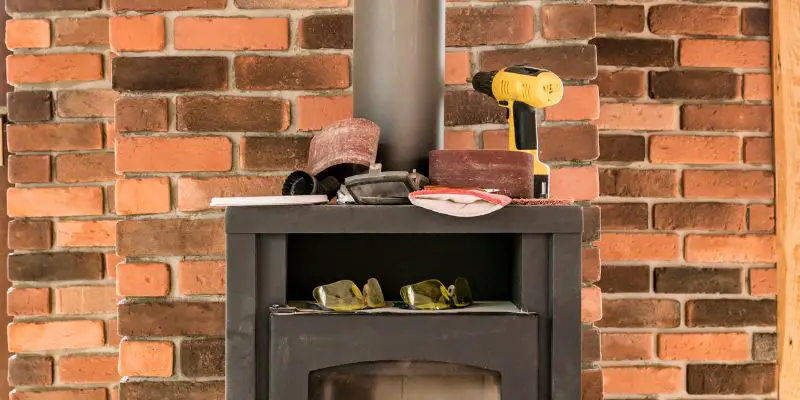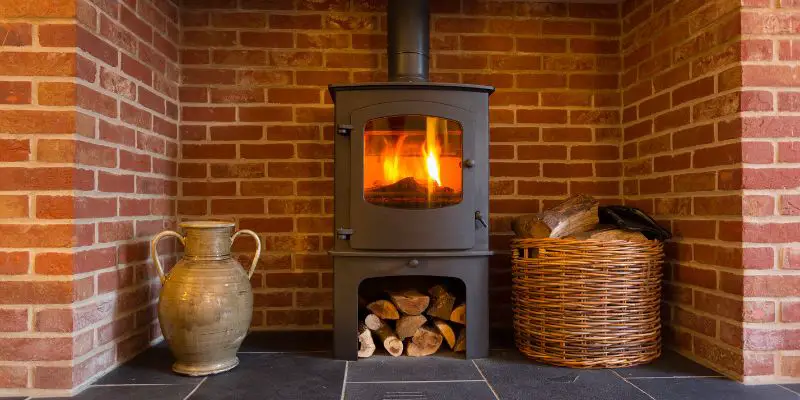To install a wood burning stove, start by choosing a suitable location and ensuring proper ventilation. Then, assemble the stove and connect it to the chimney for safe operation.
Wood burning stoves are a popular and sustainable heating option for homes that can provide a cozy and efficient source of warmth during the colder months. However, proper installation is crucial to ensure safety and optimal performance. By following the necessary steps and guidelines, homeowners can install a wood-burning stove effectively and enjoy the benefits of this eco-friendly heating solution.
We will discuss the essential steps and considerations for installing a wood burning stove, providing valuable insights for anyone looking to add this heating option to their home. We’ll cover everything from selecting the right location to connecting the stove to the chimney, ensuring that readers have all the information they need to proceed with confidence.

Planning Your Wood Stove Installation
When it comes to installing a wood burning stove, careful planning is essential for a successful and safe installation. From considering room size and location to addressing safety regulations and permitting, thorough planning can ensure a seamless wood stove installation process. Let’s delve into the key considerations for planning your wood stove installation.
Consider Room Size And Location
Before getting started with your wood stove installation, it’s crucial to assess the room size and location where the stove will be placed. Ensure that the space is adequate to accommodate the stove and that there’s enough clearance around the stove to meet safety requirements. Additionally, consider the room layout to determine the best location for the stove, keeping in mind factors such as proximity to combustible materials and accessibility for maintenance.
Address Safety Regulations And Permitting
Prior to proceeding with the installation, it’s imperative to familiarize yourself with local safety regulations and permitting requirements. Check with your local building department to determine if any permits are needed for the installation and to ensure compliance with safety codes. Adhering to these regulations is essential for the safety of your home and to avoid any potential legal issues in the future.
Assess Chimney And Ventilation Requirements
Another crucial aspect of planning your wood stove installation is assessing the chimney and ventilation requirements. Ensure that your chimney is structurally sound and meets the necessary standards for wood stove installation. Address any ventilation needs to ensure proper airflow and efficient operation of the wood burning stove.
Select The Appropriate Stove Model
Choosing the right stove model is a vital part of the planning process. Consider the heating capacity, efficiency, and compatibility with your space to select a wood stove that meets your heating needs and fits seamlessly into your home. Consulting with a professional can help in determining the most suitable stove model for your specific requirements.
Choosing The Right Stove And Accessories
When it comes to installing a wood-burning stove, choosing the right stove and accessories is crucial to ensure a safe and efficient heating system. In this guide, we’ll delve into the key factors to consider when selecting a wood-burning stove and the necessary accessories for installation.
Evaluate The Stove’s Heating Capacity
Before purchasing a wood-burning stove, it’s important to evaluate the stove’s heating capacity to ensure it matches the size of the space you want to heat. Consider the square footage of the room or area where the stove will be installed, and choose a stove with a heating capacity that aligns with your needs.
Consider Efficiency And Environmental Impact
When selecting a wood-burning stove, consider the stove’s efficiency and environmental impact. Look for stoves that are certified by the Environmental Protection Agency (EPA) for their efficiency and low emissions. These stoves not only provide better heat output but also contribute to reducing environmental impact.
Select Necessary Installation Materials
Once you’ve chosen the right wood-burning stove, it’s essential to select the necessary installation materials. This may include insulated chimney pipe, fire-resistant wall thimbles, heat-resistant stove gloves, and a stove installation kit. It’s crucial to ensure that all materials meet the safety and building code requirements for your area.
Preparing For Installation
Ensure A Non-combustible Hearth Base
Before installing a wood burning stove, it’s crucial to ensure the hearth base is non-combustible. This means the surface on which the stove will sit must be able to withstand high temperatures and prevent the risk of fire. The hearth base serves as a protective barrier and must extend beyond the stove to capture any spills or embers. It’s a key safety measure that should not be overlooked.
Clear Space And Create An Installation Plan
Prior to installing the wood burning stove, clear the designated area to create space for the stove and necessary venting. Consider factors such as the proximity to flammable materials and the ideal placement for efficient heating. Creating a clear installation plan ensures a smooth and organized process, minimizing potential challenges during installation. It’s essential to thoroughly evaluate the space and plan accordingly before proceeding.
Gather Tools Needed For The Setup
Acquiring the essential tools for the wood burning stove installation is crucial for a successful setup. Ensure the following tools are at hand:
- Level
- Tape measure
- Drill and bits
- Screwdriver set
- Adjustable wrench
- Stovepipe thermometer
- Masonry drill and anchors (if applicable)
Expert Tips For A Smooth Setup Process
When installing a wood-burning stove, expert tips can make the setup process smoother and more efficient. From pre-installation checks to safe handling practices, these tips can help ensure a successful installation. Follow these expert guidelines for a seamless wood-burning stove setup.
Pre-installation Checklist
Prior to installing a wood-burning stove, it’s important to conduct a thorough pre-installation checklist to ensure that all necessary preparations are made. The following items should be included in the checklist:
- Assess the location: Determine the most suitable location for the stove, considering clearance requirements, proximity to combustible materials, and proper ventilation.
- Verify local regulations: Check with local authorities to ensure compliance with building codes, zoning regulations, and any required permits for wood-burning stove installation.
- Prepare the installation site: Clear the area where the stove will be installed, ensuring a level and non-combustible base or platform to support the unit.
- Gather necessary tools and materials: Collect all the tools and materials required for the installation, including piping, sealing materials, and any additional components specific to the model of the wood-burning stove.
Best Practices For Safe Handling Of The Stove
When handling the wood-burning stove, safety should be the top priority. Follow these best practices to ensure safe and effective handling of the stove:
- Wear protective gear: Prior to handling the stove, wear protective gloves and clothing to prevent injury from sharp edges or hot surfaces.
- Use proper lifting techniques: When moving the stove into position, employ proper lifting techniques to avoid strain or injury.
- Secure connections and seals: Ensure that all connections and seals are secure to prevent leaks and maintain the efficiency of the stove.
- Follow manufacturer’s guidelines: Adhere to the manufacturer’s guidelines for installation, including clearances, venting, and any specific requirements for the particular model of wood-burning stove.
Steps To Install Wood Burning Stove
Installing a wood-burning stove can be a wonderful addition to your home, providing warmth and ambiance. However, it’s vital to ensure the installation process is executed properly for safety and efficiency. Here are the essential steps to successfully install a wood-burning stove in your home.
Secure The Stove In The Desired Location
Begin by choosing an appropriate location for your wood-burning stove. Ensure the area complies with the necessary clearances from combustible materials per the stove manufacturer’s guidelines. Once the ideal spot is determined, use a non-combustible floor pad to protect the flooring. Position the stove on the pad, ensuring it’s centrally located and level. Anchor the stove to the floor according to the manufacturer’s instructions to secure it in place.

Install Stovepipe And Connect To The Chimney
Utilize a straight, vertical path when installing the stovepipe to connect the wood-burning stove to the chimney. Ensure the stovepipe is constructed of properly sized and insulated materials, and maintain the manufacturer’s recommended clearances from combustible materials. Use adjustable elbows or other necessary fittings to navigate around obstacles and create the most direct route to the chimney. Once connected, secure the stovepipe to the chimney using appropriate materials such as screws or brackets.
Check For Proper Ventilation
After installing the wood-burning stove and connecting the stovepipe to the chimney, it’s crucial to verify that the ventilation system is functioning correctly. Test the airflow by igniting a small fire in the stove and observing the smoke’s upward draft through the chimney. Additionally, inspect the damper to ensure it opens and closes smoothly and seals properly when closed. Any concerns regarding ventilation should be promptly addressed to guarantee the wood-burning stove operates safely and efficiently.
Finishing Touches And Maintenance Advice
Finishing touches and regular maintenance are crucial after installing a wood-burning stove to ensure its optimal performance and longevity. Proper application of fireproof sealants and periodic maintenance routines are essential for the safety and efficiency of your wood-burning stove. Below are some essential aspects to consider for the finishing touches and maintenance of your wood-burning stove.
Apply Fireproof Sealants And Trim Work
After installing the wood-burning stove, it’s essential to apply fireproof sealants to the joints and areas where the stove meets the wall or the floor. This prevents any potential leaks and ensures safety. Additionally, consider adding trim work around the stove to enhance its aesthetic appeal and provide a finished look to the installation.
Initial Burn And Stove Conditioning
Before regular use, it’s important to conduct an initial burn to condition the stove. This helps in curing the paint and gaskets while eliminating any manufacturing residues. Start with small, controlled fires and gradually increase the temperature over a few days to condition the stove properly. This process will create a protective layer inside the stove, enhancing its durability and performance.
Routine Maintenance And Cleaning Schedules
Establishing routine maintenance and cleaning schedules is crucial for the efficiency and longevity of the wood-burning stove. Regularly inspect the stove, gaskets, and seals for any signs of wear or damage. Clean the glass, chimney, and flue to prevent the buildup of creosote, which can pose a fire hazard. Additionally, check and clean the ash pan and ash traps as part of your regular maintenance routine, ensuring they are free from any debris that may affect airflow and combustion.
Frequently Asked Questions For How To Install A Wood Burning Stove
Can You Install A Wood Burning Stove Yourself?
Yes, you can install a wood burning stove yourself. However, it’s essential to follow safety codes and regulations. Make sure to have the necessary skills and knowledge before attempting the installation. Always consult a professional if in doubt.
What Is Needed To Install A Wood Burning Stove?
To install a wood burning stove, you’ll need a flue, proper clearance from combustible materials, and a non-combustible hearth. Other requirements may include a building permit and professional installation.
Can You Install A Wood Burning Stove In An Existing Home?
Yes, you can install a wood burning stove in an existing home. However, it’s important to have a professional assess the space and ensure proper ventilation and safety measures are in place. Always check local building codes and regulations before installation.
Do You Need A Chimney For A Wood Burning Stove?
Yes, a chimney is necessary for a wood burning stove to safely vent smoke and gases.
Conclusion
Installing a wood-burning stove can be a practical and rewarding project for any homeowner. With the right tools and know-how, you can enjoy the warmth and ambiance of a wood fire in your home. Remember to follow safety guidelines and local regulations to ensure a successful and safe installation.
Take the time to properly maintain your stove for long-term enjoyment and efficiency.



2 thoughts on “How to Install a Wood Burning Stove: Expert Tips for Easy Setup”